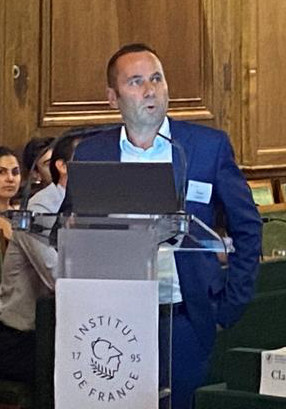 Bruno Cadot, a researcher in the “Physiopathology & therapy of autosomal dominant centronuclear myopathy” team led by Marc Bitoun at the Myology Research Centre, has just been awarded the Tremplin ASEAN prize by the French Ministry of Higher Education and Research and the French Academy of Sciences. This prize rewards existing cooperation between two teams, one French and the other from the ASEAN* zone. Its aim is to encourage cross-border mobility of young researchers. Interview with Bruno Cadot.
Bruno Cadot, a researcher in the “Physiopathology & therapy of autosomal dominant centronuclear myopathy” team led by Marc Bitoun at the Myology Research Centre, has just been awarded the Tremplin ASEAN prize by the French Ministry of Higher Education and Research and the French Academy of Sciences. This prize rewards existing cooperation between two teams, one French and the other from the ASEAN* zone. Its aim is to encourage cross-border mobility of young researchers. Interview with Bruno Cadot.
When did you start working with B. Burke’s team in Singapore?
Our collaboration with the team led by Brian Burke, Director of Research at the Skin Research Institute of Singapore, and Yin Loon Lee, a researcher in his laboratory, began in 2015 when we obtained a Merlion Grant, a 2-year scholarship awarded by the French Embassy in Singapore to encourage student and researcher exchanges. We continued our collaboration and obtained a Merlion Workshop grant in 2022, which enabled us to organise a 3-day hybrid workshop in November 2022. Five of us went to Singapore and the other members of the team followed the discussions by videoconference. Finally, in November 2022, we applied to the Tremplin ASEAN call for proposals and learned in May 2023 that we had won.
Can you describe the work you are conducting during this collaboration?
We were interested in the nucleus-cytoskeleton connection in muscle cells. Thanks to our collaboration, we have identified a nuclear envelope protein, nesprin-1alpha, which is expressed when muscle cells are formed. It is responsible for reorganising the microtubules in the forming muscle cell. When this protein is mutated or absent, the nuclei are malpositioned in the muscle fibre, leading to disease; we published these results in 2017**.
Continuing in this direction, we realised that the cytoskeleton, which is linked to the nucleus by nesprin-1, exerts mechanical forces on the nucleus. In the context of a healthy cell, everything is fine, but in the context of a disease, such as laminopathies***, the nuclei are deformed. Our hypothesis is that these deformations are caused by mechanical forces generated by the cytoskeleton linked to the nucleus, and that consequently, if we remove these forces, we can reverse the pathological effect. In a mouse model without laminin, we have shown that laminin and nesprin-1 exert balanced forces on either side of the nuclear membrane****.
What are the next steps?
We are going to test other mutations in the lamin gene, which can lead to very different pathologies: diseases of the muscles (e.g. the heart or certain skeletal muscles), but also of the central nervous system, adipose tissue, progeria, and so on. To this end, we are going to compare gene expression in these 3 models: a healthy mouse, a KO-lamine mouse and a KO-lamine + nesprin-1 mutation mouse.
We also want to understand what role the forces exerted on the nucleus play in nuclear activity, and gene expression in particular. So far we’ve only observed that removing the forces recovers normal nuclei and the mice live well, but ultimately we don’t know where the disease comes from: is it because the lamin, mutated or absent, stresses the genome and modifies gene expression in one direction or another (over- or under-expression)?
* ASEAN zone: Thailand, Cambodia, Indonesia, Malaysia, Philippines, Singapore, Vietnam.
*** Laminin is a protein forming a network on the inner surface of the nucleus that keeps it rigid. When this protein is mutated or absent, nuclei are deformed, leading to serious diseases in various tissues.
